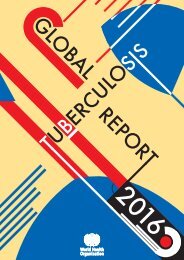patients
DNDi_AR_2015
DNDi_AR_2015
You also want an ePaper? Increase the reach of your titles
YUMPU automatically turns print PDFs into web optimized ePapers that Google loves.
R&D MODEL & PORTFOLIO<br />
DISCOVERY<br />
Drug discovery is a demanding process, particularly with the added constraints of working in a neglected<br />
area and within a limited budget. The standard “black box” approach involves screening compounds<br />
against parasites in vitro, to identify those which are able to kill the parasite under laboratory conditions.<br />
Having identified initial hits, analogous<br />
compounds are synthesized<br />
and evaluated to identify even more<br />
potent molecules in a process known<br />
as hit-to-lead. The most promising<br />
of these undergo further optimization<br />
in order to maximize antiparasitic<br />
activity, increase tolerability and<br />
safety, and optimize the amount of<br />
time a compound stays in the body.<br />
With compounds undergoing clinical<br />
development for HAT, DNDi’s<br />
screening and lead optimization<br />
efforts are currently focused on<br />
identifying compounds for Chagas<br />
and leishmaniasis.<br />
The mini-portfolio approach for<br />
filarial disease treatments aims to<br />
identify: (1 ) direct-acting compounds<br />
– by screening libraries from animal<br />
health companies and repurposing<br />
compounds for human use,<br />
and (2 ) indirectly-acting compounds<br />
– which kill the symbiotic Wolbachia<br />
bacteria – in partnership with the<br />
anti Wolbachia consortium (A-WOL)<br />
at the Liverpool School of Tropical<br />
Medicine, UK.<br />
The NTD Drug Discovery Booster<br />
was launched in 2015 as an experiment<br />
aimed at speeding up the process<br />
and cutting the cost of finding<br />
new treatments for Chagas disease<br />
and leishmaniasis (see p. 21).<br />
Medicinal chemistry with<br />
partners in the North and South<br />
Over the last decade, DNDi has<br />
worked with academic and industrial<br />
medicinal chemistry partners who<br />
are organized geographically into<br />
two consortia, in Australia (LO AUS)<br />
and the United States (LO US).<br />
In 2013 we began building a new<br />
consortium in Latin America (LOLA),<br />
providing support and mentoring for<br />
young scientists in the region (see<br />
below). The consortia undertake<br />
hit-to-lead and lead optimization<br />
activities for visceral leishmaniasis<br />
and Chagas disease (see Leish<br />
H2L p. 29, and Chagas H2L p. 38),<br />
with HAT activities on hold in case<br />
of any future need.<br />
A Latin American consortium for leishmaniasis and Chagas disease drug discovery<br />
The Chemistry Team of Prof. Dr. Luiz Carlos Dias (centre), UNICAMP.<br />
The “Partnership of the Year<br />
2015” was awarded to LOLA,<br />
a Latin American Lead<br />
Optimization Programme.<br />
The LOLA project uses an<br />
international collaborative<br />
approach, working with<br />
UNICAMP (University of<br />
Campinas), Brazil, and with<br />
partners in the USA (AbbVie)<br />
and Europe (LMPH, University<br />
of Antwerp, Belgium) to carry<br />
out early stage drug discovery<br />
and sets a precedent for all<br />
emerging neglected disease<br />
endemic countries.<br />
DNDi Annual Report 2015 › 19



